Rolf Konow, Danish Stills Photographer |
Read more at in70mm.com The 70mm Newsletter |
| Interviewed & photographed by: Thomas Hauerslev, 8. August 2013 in Rolf Konow's Copenhagen Studio. Transcribed for in70mm.com by Brian Guckian. Proofread by Rolf Konow for accuracy. | Date: 18.09.2013 |
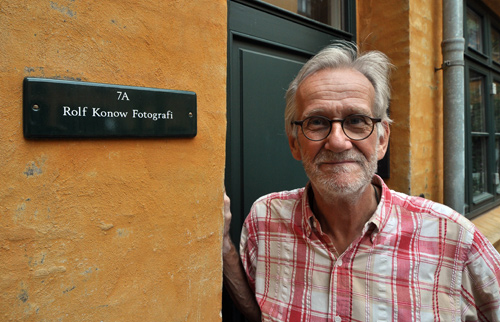 Rolf
outside his studio in central Copenhagen Rolf
outside his studio in central CopenhagenIt’s Thursday, August 8th, 2013 and I’m sitting next to Rolf Konow – and we’re going to talk about his career, his equipment and the filming of "Hamlet". Rolf, I’m starting out by asking: what is the job of the Stills Photographer on a film production? RK: My job is to make people go and see the film: I shoot still photos that are supposed to show the sense of a scene. In the old days there were photos outside the cinema – around maybe 35 photos, that people looked at before they went in to see a film. My role is to take those photos, and also photos for publicity, for magazines; and later on, books to do with certain directors. So that’s what it’s all about. TH: And in your opinion, what is a good still image from a film? RK: A good still image is something that captures the scene, in a way that will encourage people to see the film. TH: Let’s go into your career - how did you get into the movie business? RK: At one point, years ago, I wanted to be a Cinematographer, and I met a cinematographer in Denmark called Ole Lytken, who worked for Saga [Ed. – Saga Studierne] and he told me, “Start as a Stills Photographer first”. So I took education as a commercial photographer – four years apprenticeship – and I finished that. Then I had a good friend, Jan Lehman that worked in Nordisk Film, and he said, “Now, at Nordisk Film they have a Stills Photographer they are not very happy with, so try to show them your photos”. And so I got the job, and started at Nordisk Film in 1970 on "Ballade på Christianshavn", which was a movie version of a TV series called "Huset på Christianshavn". And that was my start, working with Erik Balling. After that, I worked on twelve "Olsen Gang" films – that’s how it all started. TH: You had a tremendous Danish career, and that’s a whole story in itself, but your international career – a lot of the Danish actors work abroad – how did it start for you? RK: After doing all these "Olsen Gang" films, you want to do something more than that – you try to move outwards...and so I went to the Cannes Film Festival, and met a guy called Joel H. Coler, who was Head of International Publicity for 20th Century Fox, and he gave me the chance to do Special Photography – in America you have a Stills Photographer, and a Special Photographer that comes in and takes photos apart from those the Unit Photographer takes, which they send to magazines – and the first one he put me on was "Enemy Mine" – which Wolfgang Petersen did in Munich – and seemed to be happy about my work, so I did special photography on "Aliens" for Cameron, and also on "Alien 3" for David Fincher. |
More in 70mm reading: ”Hamlet” in 70mm at Kronborg Castle Kenneth Branagh's "HAMLET" on 65mm Why drive 400 miles to see Hamlet in 70mm? 2013: A Danish Summer of 70mm Interview in Danish Internet link: • Rolf Konow • Rolf Konow @ Google • Stills @ Konow.dk • Rolf imdb.com • Bob Willoughby The Society of Motion Picture Still Photographers About Rolf in Danish • onfilm.dk • dfi.dk |
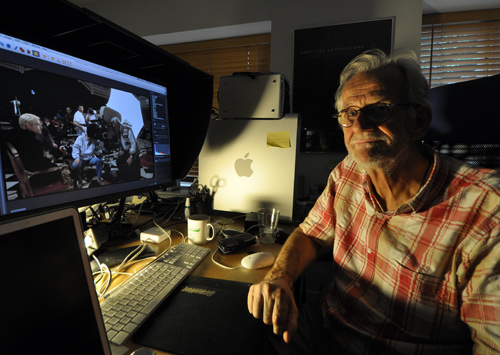 Rolf
and "Hamlet" on his screen Rolf
and "Hamlet" on his screenBut that was not my route to get into Branagh films – I worked with a company called Corbett and Keene in London – they’re a publicity company – and Liv Ullman did a film, "Sophie", and I worked on that. Then I was working in Denmark on a Danish TV serial with a director called Ole Bornedal, and I got a call from Corbett and Keene asking me if I could come and do still photos on "Othello", which was being shot in Italy with Kenneth Branagh as Iago. First I said no, because I was working on this TV serial, but then I thought, “Oh, maybe if told Ole Bornedal one time that I had got this offer, he might have said, ‘Oh you should have done that’”. Then I went to Ole and said, “I got this offer - what should I do?” “You should do it, you should do it, we’ll just find another stills photographer that’s better than you!” (Laughs) And I went to Italy and worked on "Othello", and that was my route to other films with Kenneth Branagh. After that I did "Hamlet", and then a couple of years back I did "The Magic Flute", that he also directed. So had I not said “yes” to "Othello", I would never have done "Hamlet"! TH: Great! So are you a freelance photographer, or are you employed? RK: No, no – most film people are freelance – I mean in the old days in Nordisk Film the DoP was employed...but that stopped, and then from the mid-70s all the Cinematographers were just like me – freelance. And most people are freelance – very few are employed; maybe the Producer and the Director in the film company and also some of the directors who worked for Nordisk Film – but nowadays most people are freelance. |
A selection of films Foreign films: The Three Musketeers Resident Evil Hamlet The House of the Spirits Othello Sofie Enemy Mine Special Photography: Die Hard 2 Red heat Alien 3 Aliens Enemy Mine Conan the Destroyer Danish films: Marie Krøyer Adams Æbler Dogville Pelle Erobreren Tro, Håb og Kærlighed Midt om Natten Flugten Olsen Banden i Jylland Ballade på Christianshavn Full liste |
Rolf's Equipment |
|
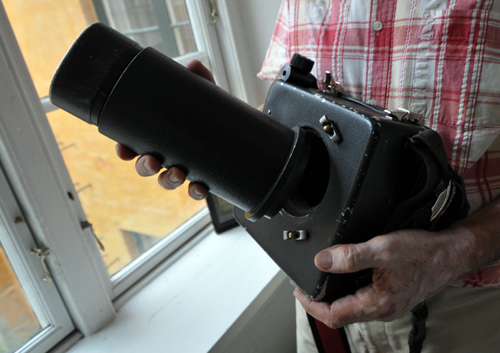 The
blimp Rolf uses for his work The
blimp Rolf uses for his workTH: I have a few questions about your equipment – because obviously a camera being used on the set with a microphone will go “click” on the soundtrack...can you explain to the readers what equipment you use? RK: When I started at Nordisk Film I did not have a blimp...a blimp is something you put your camera into, to reduce the noise – but when I started in Nordisk Film, I had a Hasselblad, which is a noisy camera, and the way I did it at that time was I asked for a still photo, and the Director would help me direct the actors, and I would take three or four photos and that was it. Sometimes with a Rolleiflex I could take six photos during a take, without the loud “click”. And then I found out through a friend in Hollywood that they had blimps – I was the first one who imported blimps into Denmark because I thought it was the best way to do it, because actors are much better when the camera is rolling, rather than if they have to do it afterwards. TH: OK; so if they set up afterwards they would look different, out of character? RK: Yes, it’s like the camera does the magic, you know the clapperboard will make them alert, and then they play, and afterwards they are relaxed – it’s difficult for them to have the same feelings afterwards. The clapperboard has the magic, and – they’re in. I think my still photos are much better if I take them then; sometimes I have to do photos afterwards because in a very small room I couldn’t be there, or there are situations where it’s not possible for me to be there and I have to it afterwards. It’s not my favourite situation; I prefer to do it with a blimp. And that means I have a camera, which I put inside the blimp, and there’s a blue button, and the autofocus, and then I take the photo. |
|
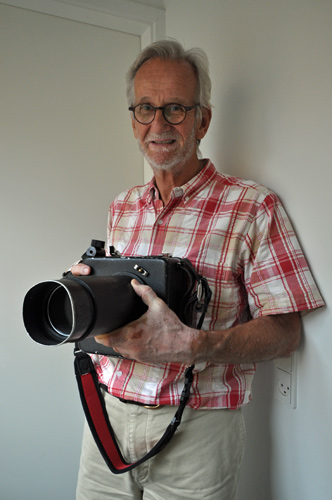 The
blimp
Rolf is using The
blimp
Rolf is usingTH: OK – you carry one camera, can you change lenses, or – ? RK: Normally I carry two blimps – one with a 24-70mm lens, f 2.8, and then I use another blimp that has a 70-200mm. I’m a Canon man, and I use Canon 5D MkIII, which is very quiet – the noise on the camera is very little, so when you put it into the blimp, it’s amazing. TH: I suppose you are using digital cameras – when did you go from film to digital? RK: 10, 15 years ago – I really can’t remember exactly when it was. It’s wonderful, because I’m in control now; before, I had to deliver my films to the lab – it’s wonderful to be able to do the final touch on a photo; it’s amazing. TH: How many stills do you take during a production? RK: It’s really different – because if you work on an action film, maybe 10,000 shots. And nowadays, unfortunately in Denmark – I mean before, I worked on 133 feature films, and for the last three or four years, five maybe, in Denmark they are saving money on still photography. So that means that normally I would start on the first day and end on the last day of the filming, and now, if I’m lucky, I have 18 days on a film which takes six to eight weeks to photograph. TH: So you are not there every day – I suppose that’s bad – RK: It’s bad for me economically of course! (Laughs) But besides that I think it’s really bad, because I’m a member of the Society of Motion Picture Stills Photographers in Los Angeles and all my colleagues in America, they work all the time, on a whole film, and I think it’s a very strange way of saving money – I mean saving money on where you have to make publicity – I think it’s ridiculous. And also, in relation to film history – they made a book about one of the actors from "The Olsen Gang" and I just worked on 120 photos for that book...now, if that would be today, I would not have those photos. And some of the film companies try to make what you call “frame grabs”, from the film itself – but the quality is not so good; I mean you can never make a poster; you cannot blow it up and make a huge photo. And that’s why the Americans still use Stills Photographers – but I don’t know why in Denmark they have found this wonderful idea to not use still photos! (Laughs) And it’s also so frustrating to be on a film set – when I arrive on the film set, they tease me: very often they say, “Oh you should have been there yesterday”. Yesterday – that would be so fantastic – you could do the poster for the film, you know! Of course they tease me, but there’s something right about that. TH: A question like this: how do you store and organise all your stills from 43 years of working in this business? RK: All the old films of course are shot on negative, on slides – I keep copies of most of them, and also I have the scanner. Nowadays, because if you copy something it has to be a file, that’s why I scan them – and the new films I have worked on are done digitally, so I have all the files. I have a RAID hard disk here, and also have one up in my apartment...so I have backed up everything. |
|
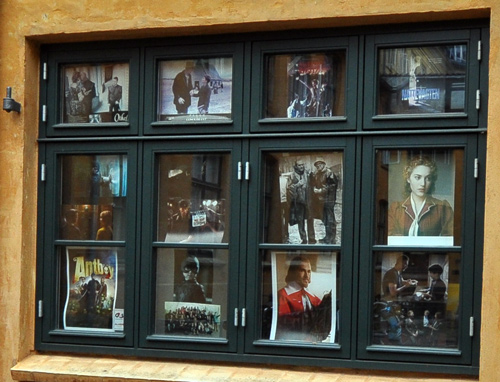 Rolf's
studio in central Copenhagen with a display of his stills in the windows Rolf's
studio in central Copenhagen with a display of his stills in the windows TH: And you can access that from where you’re working, basically? RK: Yes, I have an apartment in Mallorca, and I can log into my RAID hard disk here, and if somebody wants to use a photo, I can access my hard drive from there and start working. TH: What kind of work do you do after a day working on a film set? I suppose you go back with your camera and your stills – and then what happens? RK: I download the files, kill all the ones where they close their eyes, or are a little bit out of focus – I kill the ones I think are not good for the film. When I work on American films, or international films, the actors very often have rights to kill photos – some of them have rights to kill up to 50% of them. This is not the situation in Denmark. Also, from my experience, I always kill photos I think the actors wouldn’t like, that wouldn’t be good for the film. That’s no reason to have a lot of photos, which are just there because they’ve been taken – you kill the ones that you think are no good. I only kill it if it’s a bad photo – there’s no reason people should see that photo...it would make me look bad, also! But in Hollywood, some of the studios say they don’t want to you to kill photos – because when they process them, they can very often take part of one photo and combine it on a poster – where they have an arm from one photo, and a head from another...I mean last year I worked on a film called "Antboy", and when I saw the poster I asked, “Are these really my photos?” And then I found out that they had taken the body from one photo, and the head from another photo, and merged them together. And that poster has been done in Los Angeles. I shot the photos on a white background, and then those photos were sent to Los Angeles, and they made the poster, and combined two photos. Actually "Antboy" is in competition at the Toronto Film Festival this September. |
|
Kenneth Branagh's "Hamlet" |
|
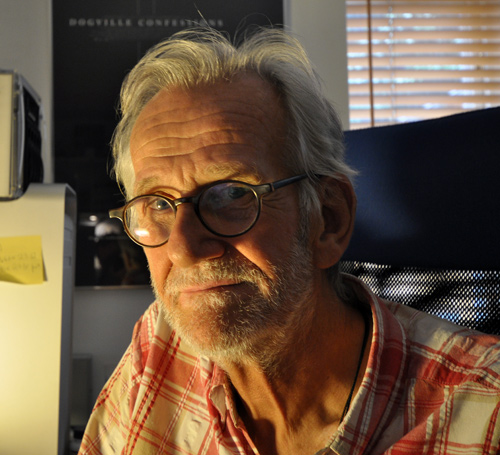 Rolf
Konow, born 1946 in Copenhagen. He has worked for 43 years as a still
photographer in the movies, in Denmark and aboard - and he is not planning
to retire any time soon. Rolf
Konow, born 1946 in Copenhagen. He has worked for 43 years as a still
photographer in the movies, in Denmark and aboard - and he is not planning
to retire any time soon.TH: Let’s get on to your adventure with "Hamlet", filmed in 65mm...I have a series of questions – we might not go through them from A to B, but you worked with Kenneth Branagh several times: how did you get to know about him? You touched on it briefly before – can you elaborate a little bit? RK: I worked on "Othello", which was shot in Italy, and then I got to know the Producer, Dave Barron, and also Kenneth Branagh...and if they like what they see, very often they will hire you on the next project. It was Castle Rock who produced it; they also produced "Othello", and the people there liked what I did, so...it’s not only the Director, its the Producers, it’s the film company, it was a lot of people who made that decision. It was not only Kenneth Branagh...the money people had a lot to say! (Laughs) The funny thing is that when I did special photography on "Alien 3", it was the same DoP who later did "Hamlet" – Alex Thomson – so I knew him also. TH: Small world! RK: Yes! TH: What kind of requirements did Mr. Branagh have for the stills for "Hamlet"? Did he ask you to do anything special? How did you decide what kind of pictures you needed for the film? RK: I just shoot – I worked with Disney, on a film called "White Fang" and they came up with a list – it was a ridiculous list because I’m there and I shoot, and I shoot, and I shoot – I shoot everything – and they came up with a list, and you had to have headshots of the actors. But I do portraits; I’m very aggressive and I shoot all the time. TH: How did you prepare – what you would like to photograph? Did you read the script? Since it’s a four-hour movie, was there a long period of preparation? How does that work for you? RK: I read the script, and the call sheet the day before shooting, and I look through what it is, and then they do rehearsals – I don’t shoot during rehearsals, because very often they don’t work the right way, so very often I shoot when they start shooting. But I look at the rehearsals and think about what I should do, and the way I should go and take the photos. TH: Who decides what to photograph – in this case, it’s basically you? RK: Yes, it’s me and only me! (Laughs) TH: What inspired you with "Hamlet” and taking the pictures of that? Any particular thing compared to other films? RK: Working on "Hamlet", and standing there as this Dane, with Jack Lemmon saying, “There’s something rotten in the state of Denmark” – I mean that’s amazing. You get goose bumps! Working with Kate Winslet...working with Charlton Heston, working with Dépardieu, working with Julie Christie – all of these, amazing! |
|
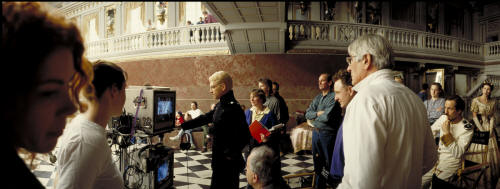 Panorama
view from the "Hamlet" set. Kenneth Branagh checking something on
the monitor, and Alex Thomson in white sweater to the right. Image: Rolf Konow Panorama
view from the "Hamlet" set. Kenneth Branagh checking something on
the monitor, and Alex Thomson in white sweater to the right. Image: Rolf KonowClick to see enlargement TH: - And Derek Jacobi – RK: – Fantastic actors – it was so inspiring to work on. The day we started, the whole crew was gathered, and Kenneth Branagh told us about how he wanted the film to be. I mean first of all he’s an Actor, and at the same time he’s a wonderful Director. And he knows his crafts – he knows exactly what it’s all about to make a film. There are actors who don’t know anything about technique, but he knows about technique. TH: I suppose that’s also why he chose to shoot in 65mm...he knew the visuals had to be fantastic on the screen. Did he talk about it, when you were there? RK: Yes – on the first day he talked to the crew about how he wanted to make this tremendous, wonderful 70mm film – I think at that point they hadn’t done 70mm in a long time, and I think Kodak paid the difference – 35mm to 65mm. TH: That’s the story I’ve heard as well. RK: For me it was fantastic because there was so much light – they shot between f 5.6 and f 8, because 65mm film has very little depth of field. TH: OK...that’s interesting – tell us about that, the lighting of the set, because they built this huge, major set, as we see on the poster. RK: There was so much light, I tell you – the funny thing was that Alex Thomson’s daughter was a Focus Puller – at one point, she had problems with the focus, and Alex said to her, “Do you want some more light?” “No, no, no!” (Laughs) For me, it was heaven, because very often you have to work on films where there’s no light at all...and here there was like, my God, there was so much light it was wonderful! TH: – That’s an interesting angle as well...I didn’t think of that, because if you shoot stills in a low light situation you cannot use a flash I suppose – you’d have to speed up the sensitivity of the film. RK: Yes – at that point it was film, and on that film I shot on colour slides and black-and-white. At that time in Denmark you always shot on colour negative – but if you worked on an international film they wanted you to shoot on slides...and black-and-white. I don’t know why they did that, because you could always get a black-and-white from a transparency; you could just go and make one – but they wanted to do it that way. |
|
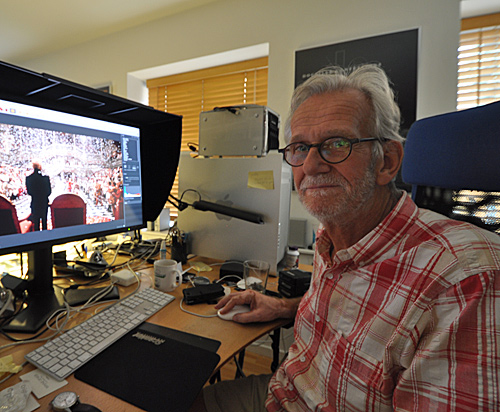 Rolf
and "Hamlet" on his screen. Rolf
and "Hamlet" on his screen. TH: How was it to work with Alex Thomson? I met him – he was a very nice man; I met him in Bradford. RK: He was a very nice man – as I said before I worked with him briefly on "Alien 3" – such a wonderful gentleman – he would never scream at people – I mean that’s not normal, but there are people who get nervous...but he was fantastic. TH: Did you co-ordinate with him on the look and feel of the pictures, or like you said before, you just take pictures – or did you talk with him about how the pictures you took should match with the pictures he took? RK: They had monitors, and I tried to see what they had on their monitors – what it looked like – and then we saw rushes, in the cinema, where I could see how the look was. The thing is, at that time you delivered your stuff to a lab, and they were the ones who made duplicates. Now, I do everything on my computer here. But before, I just delivered it to the lab and I didn’t see them until much later. TH: But did you co-ordinate anything with Alex Thomson on the look and feel of the stills? RK: No, I did not, no – not normally. TH: OK – let’s move on to the relationship between the Actors and the Stills Photographer – can you tell us a bit about that? What I mean is, maybe you come onto the set – you don’t know anyone – they don’t know you – how do you make them feel comfortable and react so you can take pictures of them? RK: You try not to be too aggressive, you know, and get in their face and start photographing them. On "Hamlet" there were two things I can tell you: the publicist once said to me, “Go and take a photo of Charlton Heston, when he gets his beard on” – and I went in, near him, and started taking photos. He looked at me and said, “Rolf, don’t do that, because, as CCB said, ‘It takes away the illusion’” (Laughter) That was Cecil B De Mille, 40 or 50 years ago, on "The Ten Commandments". And then another thing, with Julie Christie: as I told you before they have the right to kill photos, and she came up to me one day and said, “Rolf, I have killed some photos, but it’s not your photos I don’t like, it’s me I don’t like!” That was sweet! TH: Do all actors have the right to reject pictures? Or some actors don’t care about it? RK: They have the right, and very often they have agents...the worst part is if they give the photos to the agents, and then they start killing photos...because they are afraid of the actors, so kill much more photos than the actors would. But it’s understandable, because it’s their image that has to come out...on newspapers, and big advertising billboards – whatever. So it’s OK for me. |
|
 Three
examples of Rolf's beautiful gallery images. Left: Derek Jacobi as
Claudius, Kate Winslet as Ophelia and finally - 70mm legend - Charlton
Heston as Player King. Images: Rolf Konow Three
examples of Rolf's beautiful gallery images. Left: Derek Jacobi as
Claudius, Kate Winslet as Ophelia and finally - 70mm legend - Charlton
Heston as Player King. Images: Rolf KonowTH: Did you make special pictures for "Hamlet"? RK: They’re called Gallery Shots – I had a small studio, like this room here, and I had put up a grey background, and flashlights, you know, and then all the actors came in – Charlton Heston, Kate Winslet, and so on – and I photographed them in whole figure, and did portraits of them. I remember one day, my flash system completely broke down, and Jack Lemmon was in there – “Don’t worry, don’t worry, I’ll come back” – I was sweating! TH: He was a nice man – RK: Yes, a fantastic, wonderful man. TH: The gallery shots – is that something the Studio asks for? Is that also something you decide? RK: No – the Studio asks for it. On the film I worked on last year, "Antboy", we had the gallery shots also, for the poster. And when I did "Dogville", it was my idea, I said, “I think we should do a gallery shot of all these wonderful actors”. And I had a background, and a flash unit, and made a gallery shot of all the actors. |
|
 Kenneth
Branagh to the left and Alex Thomson with the Panavision System 65 camera. Foto: Rolf
Konow Kenneth
Branagh to the left and Alex Thomson with the Panavision System 65 camera. Foto: Rolf
KonowTH: Did you work on the whole filming of "Hamlet"? We talked before about how you only worked some days – RK: No, I did not work on the whole film. Unfortunately, the problem was I had already made an agreement with Bille August to do "Smilla’s Sense of Snow", so the last two weeks of "Hamlet" I did not do – somebody else came in and took over. I had already made the commitment, and luckily they agreed to that. TH: What are your recollections of the 65mm camera equipment on the set – technicians, special care, Mr. Branagh’s excitement – any difference to all the other film shoots you’d been working on? RK: For me I think it was fantastic to work on 70mm – I mean it doesn’t make it any different for me, except that I got a wonderful lot of light – but besides that, it’s wonderful to be on a film of that scale – I think it’s fantastic. TH: Did they have several sets working at the same time? Or was it only one camera crew, and the actors – or several cameramen? RK: No, there was no Second Unit...because I think we only had one or two cameras. We shot in the studio, and then we shot also at Blenheim Palace, near Oxford. We shot studio at Denham. TH: But when you see the film, it’s so dynamic, and there’s so much material in it, and when you compare it to "Cleopatra", which took three years to make – they made a four-hour film in six, eight weeks perhaps – RK: Maybe twelve – TH: - It must have been extremely hectic, every day, to make sure they had done all the scenes – RK: When they shot, very often they had a dolly, and two big stages that were built at Shepperton – they had a dolly which went from one part, travelled, with the actors, through the whole of the set...sometimes it was very difficult because we had one of the big set-height mirrors – TH: I remember that – RK: – I was so afraid to be in the mirror, because it would be a killer! (Laughs) TH: I remember the scene – it is quite amazing...they run around, the camera turns – you never see anything – you never see the crew, there are no lights or anything – RK: They were also able to turn the mirrors when we were shooting...it was amazing. |
|
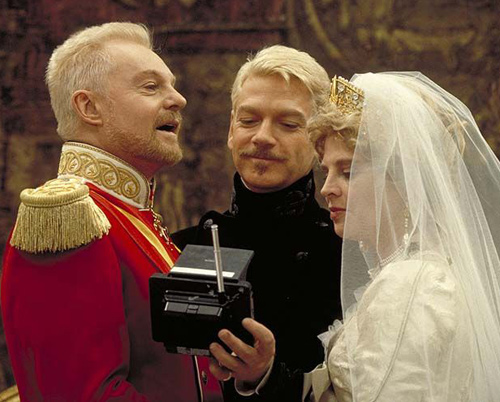 Derek
Jacobi, Kenneth Branagh and Julie Christie between takes. Image by Rolf
Konow Derek
Jacobi, Kenneth Branagh and Julie Christie between takes. Image by Rolf
KonowTH: Tell me about a normal day on the set, with the cast and crew – from your perspective as a Stills Photographer – what time do you start? At breakfast, and then you chat – ? RK: Yes, on all the big films you start with a big breakfast...I mean everybody has breakfast. Sometimes if they have a lot of things to do, they have a running lunch – that means that you don’t have a specific time for lunch; there will be something, and you can grab it and eat it, but that’s not normal – it’s when they are behind schedule, things like that. But besides that, you start in the morning and you have your breakfast. The Director and the First AD go to the set, and then there are rehearsals without the crew there. The idea is the Director and the Actors, and maybe the Director of Photography, go through the scene and then you and the rest of the Crew have a cup of coffee outside the set until you’re called in, and you see the scene. Then the actors go to Make-up, and the DoP starts lighting the scene, and when that is done, we start shooting. TH: I was thinking...the big scene on the poster, with confetti coming down – when you see that in the movie, the camera is behind Kenneth Branagh – did you mange to take a picture of the same thing – did you stand next to the camera? RK: I stood next to the camera. A couple of days later I went through the photos with David Barron, who was the Producer of the film, and who did many of the "Harry Potter" films. But he saw that photo, and said, “That’s got to be the poster”. TH: How far into production were you when you did that scene? Do you remember that? RK: I think maybe halfway into the production – |
|
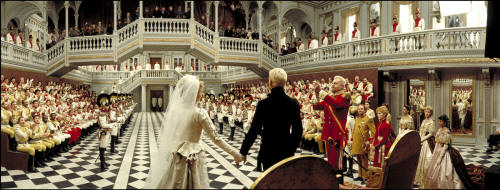 Panorama
view from the "Hamlet" set. The wedding scene. Image: Rolf Konow Panorama
view from the "Hamlet" set. The wedding scene. Image: Rolf KonowClick to see enlargement TH: It’s a big scene: lots and lots of people. RK: I had a panoramic camera that I took some photos with – TH: A Widelux? – RK: I think it was called “Horizontal” or something like that – it took pictures like this – “Zizzzt” [Gestures]. Some of the photos that I can show you were taken with that panoramic camera. TH: Great – we have talked about it, but how much time do you spend on the set – is that a full working day? RK: Oh yes – from when you start in the morning to when they say, “It’s a wrap”. TH: What time is that, typically? RK: On international films, it’s a twelve hour day...in Denmark it’s an eight-and-a-half hour day. And you can have overtime on top of that, also. So you could sometimes come up to sixteen hour days, nowadays, on international films. In Denmark you very seldom have overtime. TH: On a shooting schedule of eight weeks that’s a tough working schedule. RK: Yes – but big international films are twelve weeks. The last big film I did was "The Three Musketeers" – it was shot in Germany, and it was twelve weeks, with a twelve hour day. In Denmark it’s six to eight weeks, with an eight-and-a-half hour day. TH: So you were exhausted I suppose, after a production like that! RK: Yes, to come back to work on a Danish film, it’s like going on holiday! I think the tough thing is the last few hours – |
|
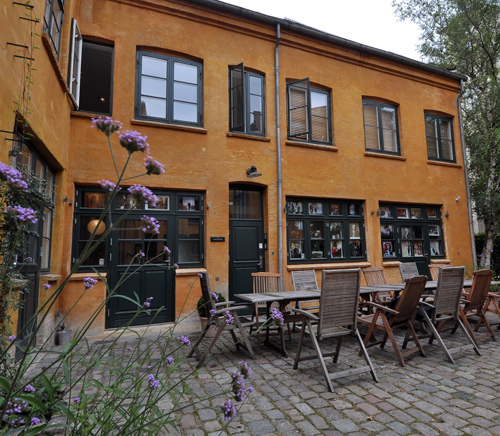 Rolf's
studio in central Copenhagen with a display of his stills in the windows. Rolf's
studio in central Copenhagen with a display of his stills in the windows. TH: – to keep focus on the camera. RK: Yes. TH: How much time did you spend with the "Hamlet" production – before, during and after the film? You talk about during the film: was there any time before it started? RK: No – I get the script, I read it, I start shooting, and then when I went back to Denmark and worked on "Smilla’s Sense of Snow", everything was at the lab, and the producers and the film distributor are the ones who decide on the poster, all the photos and books, and things like that. So, I’ve nothing to say there, except to deliver some good photos. TH: The Stills Photographer – is it his pictures that the company can use, in this case the "Hamlet" production company – how does that work? RK: The thing is, I have no right to those photos; it is the film company who owns those photos. But in Denmark it works another way – in Denmark I’m paid by the film production to do still photos for the film, but if they’re used for books or other things - let’s say a Danish book is coming out, about "The Olsen Gang" – I’m paid by the book publisher, for those photos. But on international films I’ve no rights. TH: But you have the pictures from let’s say "Hamlet" – they’re in your possession – RK: But if I want to publish them in a book I have to get the rights from the film company. TH: And if they need the original pictures - ? RK: They have the originals – I just get some dupes: some paper prints, or some duplicates from the slides. But they have all the photos in their files. TH: So that’s how it works for any Stills Photographer? RK: Yes – the only difference, now that it’s gone digital, I have the digital files. But because of the kills on big films, I cannot just go and use some of the photos because I do not know if these photos are OK with the actors. So therefore I always get a proof from the film company – if I need to show people some of my work, it’s important that it’s not something that the actors don’t want. TH: (Laughs) RK: I would be in big trouble, yes! TH: What are your most memorable moments from the set of "Hamlet"? Any fun anecdotes in relation to your work; photographic publicity; behind-the-scenes; cast and crew – they want pictures as well? RK: Yes, but to be honest, it’s too many years ago. The funny story I told you about with Charlton Heston, and also what he told me. TH: And what did you think of the film when it came out? Have you seen it in 70mm? RK: I’m going to see it on Saturday! [Ed. – Special screening in Kronborg, 10.8.2013] I have it on DVD...two DVDs because it’s so long! I’m looking forward to seeing it in 70mm, because in Denmark they didn’t show it...so, it’s going to be great! |
|
Iconic Poster Images |
|
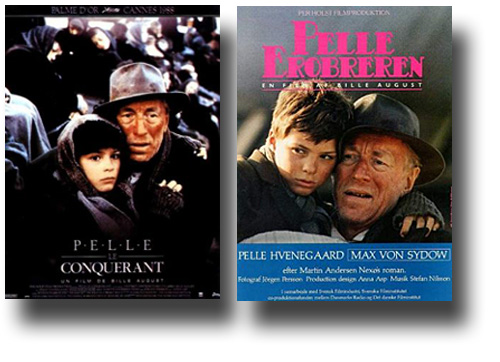 The
French distributor liked the darker "Pelle" poster and used it in France. To
the right, the Danish version. The
French distributor liked the darker "Pelle" poster and used it in France. To
the right, the Danish version. TH: For me, being a Dane, you have done some very iconic pictures, and I’m thinking of "Pelle the Conqueror" with Max von Sydow and Pelle Hvenegaard – can you tell us about how that picture came about? RK: We wanted to do a poster on the boat – where Pelle and Max are together, with a lot of extras. I was in Los Angeles, visiting some publicity people, showing them my photos, and I was showing that photo that we took on the boat – they looked like refugees – it looked depressing. Of course there were the wonderful figures of Pelle and Max; they looked great, but the whole surroundings looked really sad. I showed them the photo that is now on the poster for "Pelle the Conqueror", which was shot in Bornholm, and I was not able to catch it when we shot it, because things went so fast. So I asked Max and Pelle to do it once again for me – he took him up on his shoulder, and that was the photo. And those people I showed it to in Los Angeles said, “You should use that photo”. And I told Bille, “You should use that, because the other one is too depressing”. And that’s how it came to be on the poster. TH: That’s good! ...Looking in your office you have many nice posters – some of them I remember: "Tro", "Håb og Kærlighed" and "Dansen med Regitze". Another one I wanted to ask you about – "The Olsen Gang" – the very famous – at least for the Danes – silhouettes, when they are walking about the harbour. Did you take that, or was it from before you came? RK: That was from before, and since then, all the posters have been drawn posters. I came in on the third "Olsen Gang", and at that time they had already made the one with the – TH: - There were the three gangsters – RK: - Exactly. Unfortunately it’s not mine! TH: You compensate dearly, with the rest of them! RK: I had to live with it, but that’s OK. |
|
My Favorites |
|
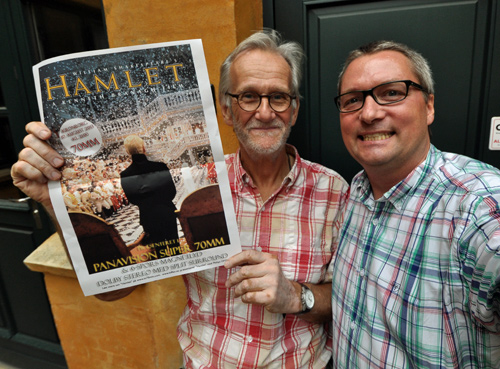 Rolf
Konow and Thomas Hauerslev, outside his studio Rolf
Konow and Thomas Hauerslev, outside his studioTH: Do you have any other favourites of your own? Being a Stills Photographer, what kind of posters or pictures do you admire, from others of your peers? RK: The guy that inspired me to get the blimp, a guy called Bob Willoughby, he was a Special Photographer – he was not like me, a Unit Photographer on a film, but he came in then and did specials...he’s made wonderful books, and he was my big inspiration. Also, he was the one that I read about with that blimp; also a guy called Mark Jacobson whose father I visited in Los Angeles, and got the first blimp from him. But Bob Willoughby was one of my big inspirations, I would say. TH: Did he make any posters we should know of...or pictures? RK: I don’t know if he made posters, but he made wonderful books with Audrey Hepburn, and all of them are fantastic. TH: I’ll look it up. RK: – Bob Willoughby. TH: OK, something about your favourite movie...what are your favourite movies? Like say, 1, 2 and 3? RK: Normally I would say, the film I’m working on right now! (Laughs) It is so difficult! It’s like what food do you like – do you like sushi, or beefsteaks, or do you like lobster...I don’t know, it’s difficult. "Pelle the Conqueror", and "Hamlet", also...but then I worked with so many wonderful Directors – Anders Thomas Jensen...also working with Lars Von Trier, on "Dogville" – "Breaking the Waves" was also a fantastic experience. TH: From my perspective, being in the audience, I don’t see the production. But when you go onto the production, you are there, on the full production, every day, and you see the nuts and bolts, and the laughs and cries, and the problems and the highlights – everything. What’s it like to see the final product – maybe months, years after the film was made? Is that strange, because you must have all this “meta-information” about the day you did this, and the day you did that – RK: Sometimes it’s a wonderful experience, and sometimes it’s – ughhh! TH: Can you say why? RK: Sometimes you think it would have been better, but normally it’s a wonderful experience. I take that back, because the thing is that when you work on a project, you love it even though it’s not that fantastic. It’s very difficult not to care for what you’ve done, I think. TH: Something completely different – what’s your favourite cinema – where do you go to enjoy movies? RK: Of course Imperial Bio, and Dagmar, and Grand Teatret – and of course also, because it’s not that far away from me, the Empire Bio – it’s a wonderful cinema. TH: My final questions are: you’re still very busy? Like three to five projects a year? RK: Not much anymore, because now they are trying to cut down on Stills Photography. TH: You’ve been working for 43 years; you’ve worked on 134 films, and you’re 67 – any plans on retiring? RK: No – as long as somebody wants me to do what I’m doing, I love it, it’s fantastic. TH: Thank you for your time, it’s been a pleasure, and if you want to add something – I usually end my interviews by asking the interviewee if they want to add something – RK: Thank you! I think we’ve been through a lot of things – if something comes into my mind I will give you a call! |
|
| Go: back - top - back issues - news index Updated 22-01-25 |
